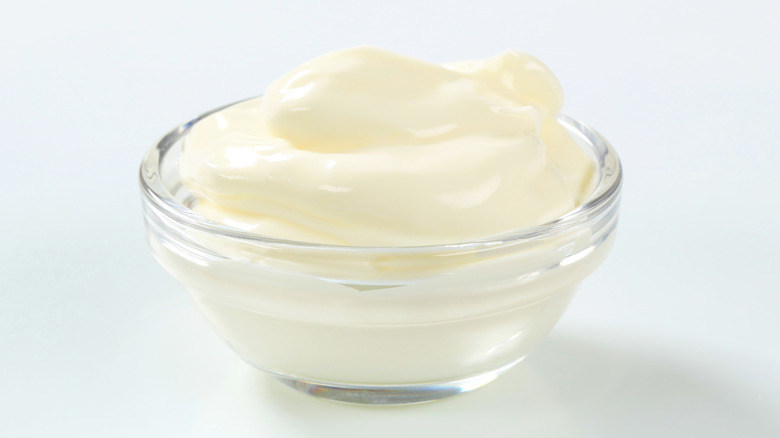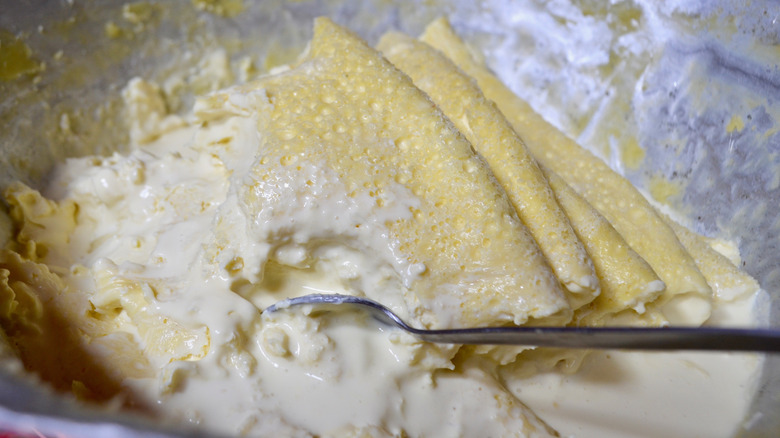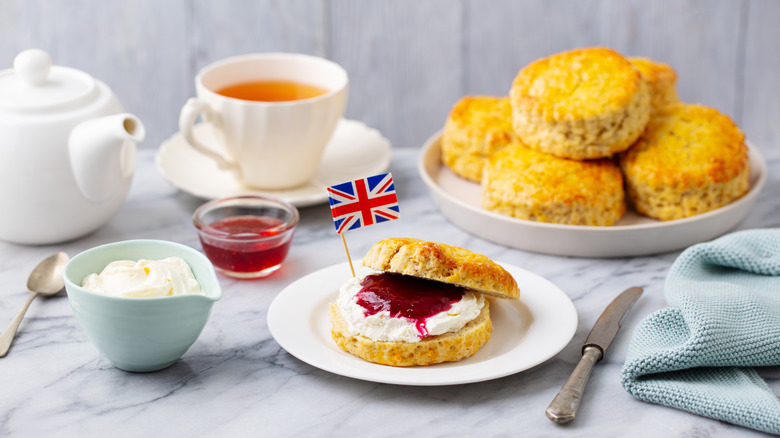What Is English Clotted Cream, Exactly?
Clotted cream is a quintessential aspect of teatime in England, typically served with sweet, crumbly scones. But in other parts of the world, it's a niche item that, for the most part, flies under the radar. The best way to describe it to the uninitiated would be like a cross between whipped cream and butter — soft, sweet, and incredibly rich.
Clotted cream is simply cream that's been thickened over heat, unlike whipped cream, which is thickened via, well, whipping naturally. The true defining factor with clotted cream, though, is its fat content. Clotted cream is classified as containing a minimum of 55% butterfat, often eclipsing 60%. To put this into perspective, heavy cream contains 36% butterfat, and butter itself contains around 80%.
Clotted cream is intrinsically linked to England, but particularly to the southwestern counties of Devon and Cornwall where it originated. It is sometimes known as Devon cream, Devonshire cream, or Cornish cream, and both counties have hard opinions about its proper use. It's also widely produced throughout Yorkshire county. But once you venture off the isle of Britain, you'll find it much harder to come by. That's because clotted cream, as a dairy product, has a short shelf life, and it's difficult to export without it spoiling. When you do find it in American grocery stores, it tends to come with a high price tag, running about three times the cost of whipped cream. Fortunately, clotted cream is easy to make at home.
How clotted cream is made
Clotted cream originated as a means of preservation. Fresh cream was once hard to come by, as you couldn't buy it by itself. Instead, you had to extract the cream from cow's milk, separating it from the whey. This was important to do in the days before refrigeration, as whey can easily become infested by bacteria.
By separating the cream, you could extend its shelf life, if only for a brief period (there's only so much you can do with dairy). This could be done by just leaving the milk out overnight. But if you placed the milk over low heat for many hours and then cooled it for just as long, the cream would form thick "clots," for which "clotted cream" is named. This method has the serendipitous side effect of creating a luxuriously rich product perfect for spreading.
If you wanted to take the old-school route, you could make clotted cream from milk. But now that heavy cream is widely available in stores, it's much easier to start with that. For the most hands-off method, pour heavy cream into a baking dish and place it in an oven set to very low heat, around 175 degrees Fahrenheit. Bake it for around 12 hours. You should see the thick cream separate from the watery whey. Place the baking dish in a fridge overnight, and in the morning, you should be able to scoop off the clotted cream.
How to use clotted cream
Clotted cream is traditionally served as part of cream tea — a small meal consisting of hot tea served alongside scones, jam, and clotted cream. Cream tea has a long, proud history, said to have originated in the 11th century.
Manuscripts recovered from Tavistock Abbey in Devon reveal that, when workers were restoring the building following a Viking raid, the Earl of Devon served them bread, jam, and clotted cream as a reward. Over the ensuing years, scones replaced bread as the vehicle of choice for clotted cream, although a type of sweet roll called a Devon split may also be used. Cornwall also has a version of the bread, called a Cornish split, which is slightly larger than its Devonian cousin.
The proper use of clotted cream has sparked a heated rivalry between Devon and Cornwall, regarding the order in which toppings should be placed on a scone. Devonians claim that you should spread the cream on your scone, followed by jam on top, but the Cornish insist it should be jam first, followed by cream, so that the jam protects the cream from melting on the warm scone. Unless you claim loyalty to one of these counties, the choice is up to you. Aside from on scones and other breads, such as splits and crumpets, the best way to use clotted cream is by spooning a dollop on top of some fresh berries — a perfect summer dessert.


